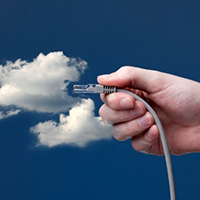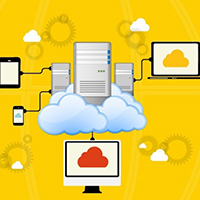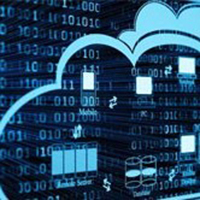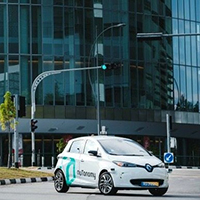In This Issue
- Cloud Revolution Here
- More Important for Biz
- Cloud Network Metrics
- Report from the CEO
- Security Force Fields
- Industry 4.0 Network
- Cloud Mgt Platforms
- Cloud Cybersecurity
- SMBs in Hybrid Cloud
- 10 Hybrid Cloud Stats
- Dynamic Approach
- Best Hybrid Vendors
- Future of the Internet
- Before Deploying Edge
- Next Data Processing
- Fog Computing Report
- Coming DCIA Events
Next Phase of Cloud Computing Revolution
Excerpted from Forbes Report by Dan Cordingley
 Few trends in information technology (IT) have had a greater impact than the rise of cloud computing.
Few trends in information technology (IT) have had a greater impact than the rise of cloud computing.
In 2016, Amazon Web Services (AWS), the leading public cloud provider, brought in $12.2 billion in net sales, a 55% increase over the previous year.
Today’s startup companies are practically required to have a cloud strategy or risk losing funding.
Not to mention, just about every enterprise CIO has cloud migration and security in his or her top strategic mandates, and about 70% of organizations have at least one application in the cloud.
The cloud has won, and its momentum is only expected to increase.
However, not every company is equally well-positioned to move to the cloud.
Companies will need to adjust their strategies and approach to remain competitive over the next decade.
Many companies still have legacy applications that can’t easily make the leap without being modified or rewritten, which is often infeasible given the cost… Read More
Cloud More Important for Businesses
Excerpted from Information Age Report by Nick Ismail
 When you use a cloud computing service, you don’t have to worry about maintaining the system yourself.
When you use a cloud computing service, you don’t have to worry about maintaining the system yourself.
All of this is done for you, and the cloud computing service will deal with all security and software updates as well, which means far less for you to worry about
Every day, people have seen technology become more and more advanced.
This has provided both consumers and businesses with many benefits.
People now have more flexibility and easier life than ever thanks to advancements in technology.
The business world has benefited hugely from today’s advanced technology.
Both general consumers and businesses these days are keen to save money when it comes to technology for the home or business.
For businesses, cloud computing does offer a very cost effective solution and it is perfect for smaller businesses without the resources or money to invest in secure systems in-house… Read More
Network Metrics for Cloud-Driven World
Excerpted from CloudTech Report by Christine Cignoli
 Today’s IT teams aren’t so different from the IT teams of days gone by.
Today’s IT teams aren’t so different from the IT teams of days gone by.
They’re still committed to running businesses smoothly by testing technology, measuring the results, and re-calibrating.
But much of the technology they’re using and managing has changed dramatically.
Enterprises are much more distributed than they used to be, with more remote offices and users accessing resources from mobile devices and laptops, sometimes many miles from headquarters or a branch office.
Add to this the ever-more-important challenge of providing those end users with good performance.
Constant uptime is now just an expected baseline, and IT teams today will get helpdesk tickets more often from application slowdowns than from actual outages.
But helpdesk tickets are harder to close now that those applications are hosted somewhere in the cloud or a provider’s data center… Read More
Report from DCIA CEO Marty Lafferty

This week, the DCIA salutes the National Institute of Standards and Technology (NIST) for releasing the final draft of its National Initiative for Cybersecurity Education (NICE) Cybersecurity Workforce Framework.
In the relatively new and rapidly growing field of cybersecurity, employers, recruiters, employees, and applicants will all benefit from being able to achieve a higher degree of industry-wide consistency in writing job descriptions and creating related work definition products.
NIST’s framework, now in its third version, was created with input from government agencies, the private sector, and academia.
The framework addresses the description of tasks, duties, roles, and titles of cybersecurity professionals.
A common language for skill sets required to fill various cybersecurity job openings should streamline recruitment and hiring processes for all participants.
The NICE Cybersecurity Workforce Framework also enables organizations and enterprises in similar lines of business to adapt a common vocabulary for the knowledge, skills, and abilities of cybersecurity professionals, as well as work categories, role definitions, and specialty areas.
It will also serve as a resource for developing additional communication tools by offering guidance on various aspects of workforce development, planning, training, and education, including curriculum and certification programs.
In addition, it will foster greater clarity in analyses and studies related to the cybersecurity workforce overall. Share wisely, and take care.
Companies Need Cybersecurity Force Fields
Excerpted from Recode Report by Mike Armistead
 There is a fracture in our modern way of life.
There is a fracture in our modern way of life.
The crack is imperceptible to most, even though it’s a dire threat.
The public sees the recent headlines about the HBO hack and the company’s proprietary information being held ransom for $6 million, or reads reports of last year’s DNC breach.
But these news stories don’t inspire anxiety the way that, say, a terrorist shooting would.
Perhaps understandably, the concept of leaked “Game of Thrones” episodes or illicitly shared emails seems, to many people, cause for personal embarrassment, not national emergency.
Now imagine that the same bad actors attack the US electric grid with malware and cause a multistate outage.
It has already happened in other countries.
Or cyberterrorists breach our water-treatment facilities and tamper with the ratio of chemicals in the cleaning process.
Or what if so-called “black hats” shut down ATM networks and the banking system… Read More
Choosing an Industry 4.0 Networking Solution
Excerpted from Control Engineering Report
 Industry 4.0 is becoming a reality for many and is bringing with it a host of benefits for both consumers and manufacturers, including lower costs, faster production, better resource efficiency, higher quality control and greater traceability.
Industry 4.0 is becoming a reality for many and is bringing with it a host of benefits for both consumers and manufacturers, including lower costs, faster production, better resource efficiency, higher quality control and greater traceability.
The key enabling technologies that will allow Industry 4.0 to deliver these benefits are the Industrial Internet of Things (IIoT) and cyber-physical systems, combined with cloud and even “fog” computing.
The IIoT enables multiple devices to exchange data using Internet and Ethernet based technologies while cyber-physical systems are the actual machines or systems that will produce and/or consume the data and use it to help guide and coordinate their actions with other parts of a manufacturing process.
Ensuring sufficient performance is a key requirement for Industry 4.0 success so manufacturers planning to move towards these smarter factory concepts need to consider the impact that their chosen network technology might have.
It is clear that industrial control networks are central to Industry 4.0 and will be based on Ethernet… Read More
Evaluating Cloud Management Platforms
Excerpted from TechTarget Report by Jason Sparapani
 A sensible first step in sifting through the jumble of public and private cloud computing services is shopping for a cloud management platform, software that helps manage how applications are deployed and operated in multicloud computing environments.
A sensible first step in sifting through the jumble of public and private cloud computing services is shopping for a cloud management platform, software that helps manage how applications are deployed and operated in multicloud computing environments.
The market, though evolving, has already fragmented into products with different designs and capabilities, according to the Cloud Standards Customer Council (CSCC), a user group that works to establish industrywide standards for cloud computing.
In a webinar late last month, the CSCC enumerated evaluation criteria for buying cloud management software.
The webinar followed the publication of the report “Practical Guide to Cloud Management Platforms.”
William Van Order, who works on cloud service management at aerospace and defense giant Lockheed Martin Corp., broke down the criteria into three categories: technology and architecture, operational, and business and acquisition.
Below are highlights of those items; for the full criteria, view the CSCC report.
Organizations must first determine whether the product under consideration provides a single pane of glass… Read More
Cloud Computing Security
Excerpted from JDSupra Report by Jim DeGraw
 Clients call us up frequently and say that they are considering going to a cloud computing strategy.
Clients call us up frequently and say that they are considering going to a cloud computing strategy.
And one of the things that we start talking to them about quickly is, what are they doing today to protect the data in their network, and what are they thinking about moving to and how are they protecting the future when it goes to the cloud.
For cloud security, we often times find clients have taken a traditional approach and they have built themselves a nice solid box around their data – so they have their unimportant data, they have their somewhat important data, and they have their very important data all built in carefully and placed within that box.
That box is a nice solid wall – there’s only one or two access points in it and it’s great.
What happens is a client begins to explore moving data outside of it, so next thing you know the cheap data goes outside.
And someone had a great idea, “Let’s put it in a cloud service where it’s low cost – yeah, we don’t care about it, it’s cheap – if the data is lost, if the data is breached, we don’t care… Read More
SMB Benefits in Hybrid Cloud Technology
Excerpted from Formtek Report by Dick Weisinger
 Increasingly reports are showing that businesses are choosing the public cloud over hybrid cloud options.
Increasingly reports are showing that businesses are choosing the public cloud over hybrid cloud options.
But a recent report by Harvard Business Review (HBR) found that hybrid cloud, at least for now, is bringing real value to many medium and smaller companies.
In fact, the report found that businesses of all sizes benefited from using cloud technologies, but small and medium sized businesses in particulars, reported seeing the largest benefits.
A key benefit that businesses are realizing from the hybrid cloud is as a platform for collaboration, both for internal collaboration and also with partners and customers.
Nearly half of those interviewed said that the hybrid cloud option had enabled them to significantly improve their collaboration.
45 percent said that improvements in business agility and flexibility were another benefit.
43 percent said that the cloud enabled them to better analyze, act on and share their data… Read More
Hybrid Cloud: 10 Notable Statistics
Excerpted from The Enterprisers Project Report by Kevin Casey
 The tech sector loves numbers – the splashier, the better.
The tech sector loves numbers – the splashier, the better.
Cloud computing has been no exception.
Since cloud technology began revolutionizing IT shops of all shapes and sizes, we’ve seen a steady stream of lofty statistics and bold predictions about the future of cloud.
The latest and greatest numbers about cloud highlight that many organizations are in adoption mode.
“I often refer to this year as the year of the cloud land grab,” says Ed Featherston, VP and principal architect at Cloud Technology Partners.
“I liken it to the homestead years of the 1800’s in the US, when the different territories tried attracting homesteaders for mutual benefit and growth.”
In Featherston’s analogy, the various cloud vendors and platforms are the territories; CIOs and their teams are the rugged and self-reliant homesteaders… Read More
Dynamic Approach to Hybrid Cloud
Excerpted from CIOReview Report
 Cloud computing has become one of the most innovative technologies of the decade.
Cloud computing has become one of the most innovative technologies of the decade.
It simplifies data storage and provides the convenience of access from any location for real-time data, a benefit that is reaped by governments, enterprises, SMBs, as well as individuals.
It is a quite established fact that the majority of the cloud users want access to all the data stored in the cloud without having to lose its privacy.
Hence hybrid cloud’s popularity skyrocketed in the recent years as it incorporates the features of third party public and the on premise private cloud services with the cloud computing environment.
Hybridization of cloud services is gaining momentum due to gaining popularity of shift to digitalization within the business.
A hybrid cloud is the best leverage to initiate cloud computing for beginners and reduces risks of data loss.
It helps companies decide the design of the future cloud with the public to handle workloads… Read More
Best Hybrid Cloud Vendors
Excerpted from CBR Report by James Nunns
 Hybrid cloud is the future, so it’s best to know which vendor will be right for your business.
Hybrid cloud is the future, so it’s best to know which vendor will be right for your business.
The vast majority of analyst research points to the future of cloud computing being a hybrid one.
Public cloud will exist, private cloud will exist, but for most businesses, their cloud environment will be a mix.
There’s a vast mix of reasons why hybrid cloud is a better choice than being all in private or all in the public cloud – regulatory reasons, financial restraints, data privacy concerns, data location, and so on.
The largest tech vendors in the world have figured out, some sooner than others, that hybrid cloud is the future.
And, unsurprisingly, they’ve all taken steps to offer this to their customers.
CBR has put together a list of the best options in the market to help you decide what vendor is going to be the right one for your hybrid cloud deployment.
Microsoft has the size and scale to support large scale public cloud and large scale private cloud deployments, thanks to its massive data center footprint… Read More
Edge Computing: Future of the Internet
Excerpted from e27 Report by Kevin McSpadden
 For tech entrepreneurs and investors, one of the most valuable insights in the business is understanding where the infrastructure is heading.
For tech entrepreneurs and investors, one of the most valuable insights in the business is understanding where the infrastructure is heading.
Building an internet company in 2012 without integrating cloud-computing would have been a giant missed opportunity.
In the digital economy, how we live, work and play is constantly evolving and unlike previous telecommunication inventions – like the television – the change is consistently dramatic.
Over the past 10 years, the internet infrastructure has basically transitioned from Black & White to Color over, and over, and over again.
Five years ago, cloud computing was ‘the future’ and even today we talk about the cloud as if it is still a nascent technology – which, to a certain degree, it is.
Cloud companies get so much funding because in modern societies, entire companies run on the cloud – and not just their tech infrastructure but also payroll, financials and internal communications.
But, the cloud is not the future and, thankfully for us, the future has already been invented… Read More
What to Know Before Deploying Edge
Excerpted from InfoWorld Report by David Linthicum
 I explained edge computing back in May, and how it’s related to cloud computing.
I explained edge computing back in May, and how it’s related to cloud computing.
But I continue to get questions on the use of edge computing, especially on whether should enterprises begin to use edge computing anytime soon.
To make that decision, there are three aspects of edge computing that you should consider:
1. Edge computing is tactical, not strategic.
Edge computing is about putting processing and data near the end points.
This saves the information from being transmitted from the point of consumption, such as a robot on a factory floor, back to centralized computing platforms, such as a public cloud.
The core benefit of edge computing is to reduce latency, and as a result increase performance of the complete system, end to end.
Moreover, it lets you respond to some data points more quickly, such as shutting down a jet engine that’s overheating… Read More
Edge Next Big Thing for Data Processing
Excerpted from TECHYOUnME Report by Pragati Pathrotkar
 With technology reaching making gigantic strides every passing day, cloud computing will soon become passé.
With technology reaching making gigantic strides every passing day, cloud computing will soon become passé.
Edge computing will be the new paradigm with a majority of processing expected to take place at the device level.
This is based on the sound analysis of where computing is headed, as stated by an executive at venture capital firm Andreessen Horowitz.
This is because of the need for extreme rapid processing for devices such as drones, robots, and autonomous cars as they become more common.
The desired processing speed is much faster, which slows if data is sent to the cloud and wait for a response.
While most companies are still warming up to the idea of going to the cloud, some enterprises are at the point of supplanting cloud computing and move on to the next paradigm.
However, this does not mean cloud will become obsolete and will not have a key place for computing needs.
With the new paradigm, the role of cloud computing is expected to witness a dramatic change… Read More
Global Fog Computing Market Report
Excerpted from QYR Research Press Announcement
 The global market for Fog Computing is influenced by a variety of factors, an elaborate assessment of which is covered in the report.
The global market for Fog Computing is influenced by a variety of factors, an elaborate assessment of which is covered in the report.
The report on Fog Computing offers in-depth insights into the key market dynamics, notable trends, emerging opportunities, strategic dynamics of major players, and recent technological advancements impacting the growth of the market in various regions.
The study is a reliable source of qualitative and quantitative analysis of current and emerging business risks likely to shape the competitive dynamics.
The evaluation, made with the help of inputs from a wide spectrum of credible secondary sources and various primary sources, offers participants a clear picture of the trajectory of the market over the forecast period 2017 – 2022.
The findings will help stakeholders identify key factors fueling the growth of prominent segments along the forecast period. This report studies the global Fog Computing market, analyzes and researches the Fog Computing development status and forecast in United States, EU, Japan, China, India and Southeast Asia… Read More
Coming Events of Interest
Industry of Things World Europe — September 18th and 19th in Berlin, Germany. Join more than 1,000 high-level executives to rethink your technology and business strategy for scalable, secure, and efficient IoT.
IoT Solutions World Congress — October 3rd through 5th in Barcelona, Spain. This event has grown enormously in no time and is an excellent barometer and source of information, inspiration, collaboration and transformation.
2017 Storage Visions Conference — October 16th in Milpitas, CA. “New Visions for Digital Storage” will bring together the vendors, end-users, researchers, and visionaries who will meet the growing demand for digital storage for all aspects of unstructured and lightly structured data.
INTRASECT— November 1st and 2nd in Washington, DC. The first conference of its kind to engage key stakeholders in a comprehensive and engaging examination of existing and future regulatory policy governing the usage of commercial autonomous vehicles.
Government Video Expo & National Drone Show — November 28th-30th in Washington, DC. The 22nd annual GVE will feature a full exhibit floor with numerous training options, free seminars, keynotes, networking opportunities, and five new educational pavilions.
Delivery of Things World 2018 — April 23rd and 24th in Berlin, Germany. Meet the most influential DevOps practitioners and experts and discuss what DevOps means for your business.
